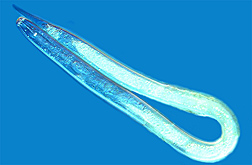Washington, DC, USA
August 23, 2011
 A U.S. Department of Agriculture (USDA) scientist has created a new weapon in the war being waged against the potato cyst nematode-a diagnostic test that identifies the type of nematode infesting a grower's field.
A U.S. Department of Agriculture (USDA) scientist has created a new weapon in the war being waged against the potato cyst nematode-a diagnostic test that identifies the type of nematode infesting a grower's field.
Xiaohong Wang, a molecular biologist with the Agricultural Research Service (ARS) Robert W. Holley Center for Agriculture and Health in Ithaca, N.Y., has filed a patent application on the monitoring tool, developed in part by cloning and sequencing key genes. ARS is USDA's principal intramural scientific research agency. This research supports the USDA priorities of ensuring food safety and promoting international food security.
There are two types of potato cyst nematode (PCN), the golden nematode and the pale cyst nematode. Being able to tell one from the other is important because breeders have developed potatoes that can resist the golden nematode, but have yet to develop varieties that resist the pale cyst nematode. If the pale cyst nematode is found in a field, potatoes cannot be grown there.
The golden nematode (Globodera rostochiensis) has been a problem in New York State since 1941 and has been found in Canada. The pale cyst nematode (G. pallida) was discovered in Idaho in 2006 and remains a major threat in Europe. Potatoes and seed potatoes are freely exchanged across international boundaries, so monitoring potato growing regions is essential.
Traditional methods of distinguishing between the two PCN species have relied on time-consuming morphological analyses and PCR (polymerase chain reaction) assays. They also require relatively large samples of nematode cysts. But Wang and her colleagues cloned the parasitism gene the nematodes use to produce a protein that plays an important role in the infection process, known as chorismate mutase.
The researchers then sequenced those chorismate mutase genes, compared the sequences, and identified unique regions in each sequence. They then developed a probe capable of recognizing the unique regions in each nematode's DNA. Wang described the process in a paper in the European Journal of Plant Pathology.
The diagnostic test is one of several new technologies designed to distinguish PCN types from each other, but it is a thousand times more sensitive than other systems and is expected to be widely used in regulatory and quarantine programs because it can give reliable results from tiny amounts of nematode material.
Read more about this research in the August 2011 issue of Agricultural Research magazine.
Photo: Juvenile golden nematode, about 1/2 mm long. Photo by Lynn Carta.
Una mejor prueba para identificar un nematodo que ataca las papas
Una científica del Servicio de Investigación Agrícola (ARS) ha creado una nueva arma contra el nematodo quiste de la papa–una nueva prueba diagnóstica que identifica el tipo de nematodo infestando el campo agrícola.
Xiaohong Wang, quien es una bióloga molecular en el Centro Robert W. Holley de Agricultura y Salud mantenida por el ARS en Ithaca, Nueva York, ha solicitado una patente sobre la nueva herramienta, la cual fue desarrollada por medio de la clonación y secuenciación de algunos genes claves. ARS es la agencia principal de investigaciones científicas del Departamento de Agricultura de EE.UU. (USDA por sus siglas en inglés), y esta investigación apoya la prioridad del USDA de promover la seguridad alimentaria internacional.
Hay dos tipos de nematodos de la papa: el nematodo dorado y el nematodo quiste. La capacidad de distinguir entre los dos tipos es importante porque los criadores han desarrollado nuevas variedades de papa que pueden resistir ataques por el nematodo dorado, pero no hay variedades que pueden resistir el nematodo quiste. Si el nematodo quiste se encuentra en un campo, los agricultores no pueden cultivar papas allí.
El nematodo dorado (Globodera rostochiensis) ha sido un problema en Nueva York desde el 1941, y ha sido encontrado en Canadá. El nematodo quiste (G. pallida) fue descubierto en Idaho en el 2006 y es una amenaza para la producción de papas en Europa. Las papas y las papas de semilla se intercambian a través de las fronteras internacionales, así que el monitoreo es importante en las regiones de producción de papas.
Los métodos tradicionales de distinguir entre las dos especies de nematodos de papa han utilizado el análisis morfológico y las pruebas basadas en la reacción en cadena de la polimerasa, las cuales toman mucho tiempo. Estas pruebas también requieren muestras relativamente grandes de los quistes de los nematodos. Pero Wang y sus colegas clonaron el gen de parasitismo utilizado por los nematodos para producir una proteína llamada el mutase del chorismate, el cual que tiene un papel importante en la proceso de infección.
Los investigadores luego secuenciaron los genes del mutase del chorismate, compararon las secuencias, e identificaron las regiones únicas en cada secuencia. Luego desarrollaron una sonda que tiene la capacidad de reconocer las regiones únicas en el ADN de cada de los nematodos. Wang describió el proceso en un artículo publicado en 'European Journal of Plant Pathology' (Revista Europea de Patología de Plantas).
La prueba diagnostica es una de varias nuevas tecnologías diseñadas para distinguir entre los tipos de nematodos de papa, pero es mil veces más sensible que otros sistemas. Se espera que esta prueba se utilizará ampliamente en programas regulatorios y de cuarentena porque podría proveer resultados confiables con cantidades pequeñas de los nematodos.
Lea más sobre esta investigación en la revista 'Agricultural Research' de agosto del 2011.